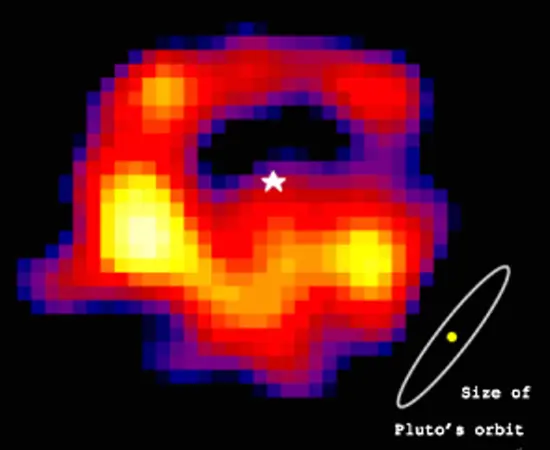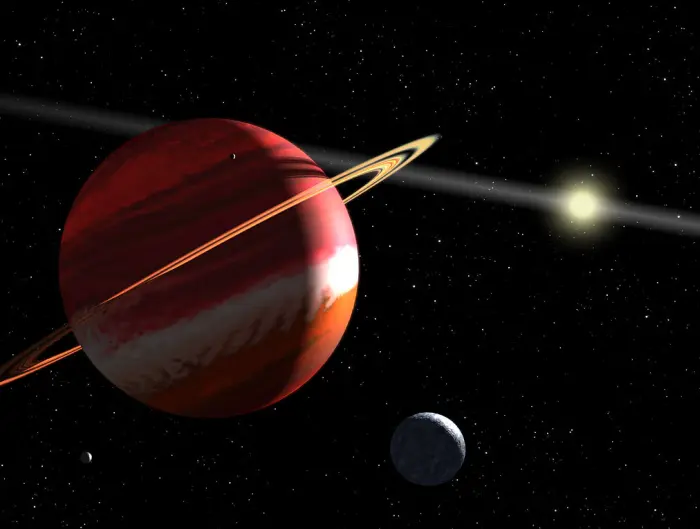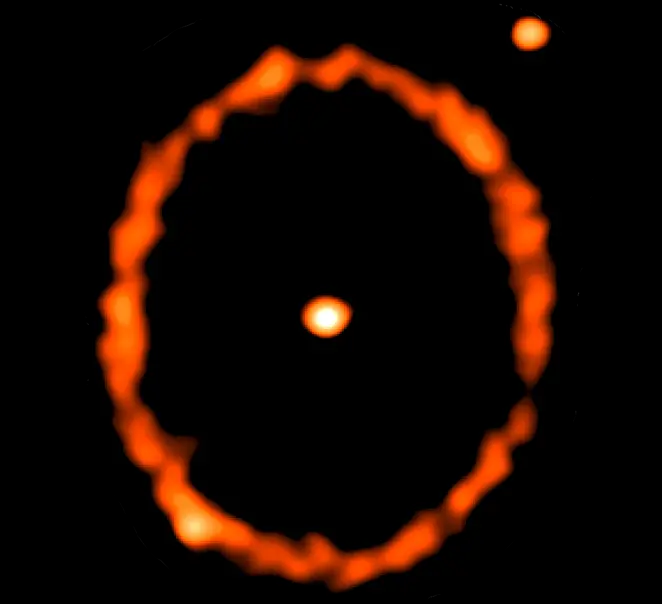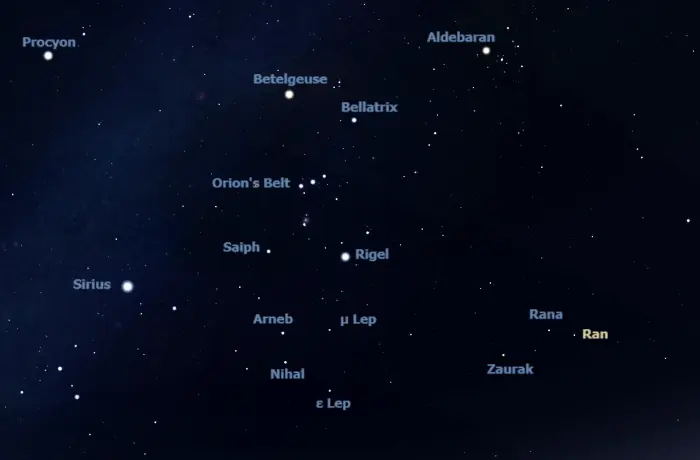Epsilon Eridani (ε Eri) is an orange dwarf located 10.475 light-years away in the constellation Eridanus. It has the proper name Ran. With an apparent magnitude of 3.736, it is the 10th brightest star in Eridanus. Epsilon Eridani is the third nearest visible star to the Sun, after Alpha Centauri and Sirius. It hosts a confirmed Jupiter-like planet, Epsilon Eridani b, discovered in 2000.
Star type
Epsilon Eridani is an orange main sequence star of the spectral type K2V. It is smaller, less massive, and less luminous than the Sun. It has an estimated mass of 0.82 solar masses and a radius of 0.735 solar radii.
With an effective temperature of 5,084 K, the star shines with 34% of the Sun’s luminosity. It spins at 2.4 km/s, completing a rotation every 11.4 days. It has an estimated age between 400 and 800 million years.
The star’s relatively young age gives it more magnetic activity than the Sun and a stellar wind 30 times stronger than the Sun’s. Ran has a lower level of metals (elements heavier than helium) than the Sun. It has 74% of the Sun’s abundance of iron in its chromosphere and less than five times the proportion of lithium in its atmosphere.
Epsilon Eridani has a strong magnetic field, about 40 times stronger than our own Sun. It has regions where magnetic activity is stronger. As the star spins, these regions come in and out of sight and the star varies in brightness by as much as 0.50 magnitudes due to starspots. It is classified as a BY Draconis variable. Other nearby stars in this class include Barnard’s Star, 61 Cygni, Ross 248, Kapteyn’s Star, and Lalande 21185.

Epsilon Eridani (Ran), image: Wikisky
Epsilon Eridani is a stronger X-ray emitter than the Sun at peak activity. The star has a hot corona, which is the source of the X-ray emission. It is also responsible for a mass loss rate about 30 times higher than the Sun’s.
Epsilon Eridani may be a member of the Ursa Major moving group, a stellar association that includes most of the bright stars of the Big Dipper. The stars of the Ursa Major association formed in the same stellar nursery about 300 million years ago and share a common proper motion. The core of the group lies 80 light-years away.
Epsilon Eridani is a spectral standard for its class (K2V). Since 1943, its spectrum has been used as one of the stable anchor points by which other stars are classified.
Distance
Epsilon Eridani lies 10.475 ± 0.004 light-years (3.212 ± 0.001 parsecs away). It is the 12th nearest individual star to the Sun and the ninth nearest star or star system. It is the second nearest orange dwarf, after Toliman (Alpha Centauri B).
Epsilon Eridani is the third closest star to the solar system that is visible to the unaided eye. Individually, it is the fourth nearest visible star, after Rigil Kentaurus and Toliman in the Alpha Centauri system in the constellation Centaurus and Sirius, the Dog Star, in Canis Major. Even though the two brighter components of Alpha Centauri are both individually first-magnitude stars, they appear as a single star to the unaided eye, so Epsilon Eridani is the third nearest visible stellar point of light in the night sky.
Epsilon Eridani was discovered to have a large proper motion, indicating proximity, in the 19th century. Proper motion is calculated by measuring the changes in the star’s apparent position in the sky compared to the background of distant stars. Observations between 1800 and 1880 indicated an angular velocity of 3 arcseconds per year.
The currently accepted parallax value of 310.5773 milliarcseconds per year corresponds to a distance of 10.47 light-years.
Debris disk
Epsilon Eridani has a debris disk with a Kuiper belt analogue. The belt lies 70 astronomical units from the star. A gap was detected in the debris disk at a distance between 20 and 70 astronomical units that indicates the presence of outer planets in the Epsilon Eridani system. However, no candidate planets have been confirmed at this distance from the star.
The debris disk was detected in the 1980s. In 1985, astronomers reported the detection of an excess infrared emission from the star, based on observations with the Infrared Astronomical Satellite (IRAS). The excess IR emission indicated a dust disk orbiting the star.
In 1998, the dust emission was imaged with the Submillimetre Common-User Bolometer Array (SCUBA) on the James Clerk Maxwell Telescope at Mauna Kea Observatory in Hawaii. A team of astronomers led by J.S. Greaves made an unexpected discovery of a substructure within the dust ring and presented evidence for a planetary system. The asymmetries in the disk and the clumps in the dust distribution indicated the presence of a planetary companion inside the ring.

Submillimeter image of a ring of dust particles around the star Epsilon Eridani. The image was taken using the SCUBA camera of the James Clerk Maxwell Telescope. Image credit: Jane Greaves (CC BY-SA 3.0)
In the late 2000s, observations with the Spitzer Space Telescope detected two asteroid belts and a cloud of exozodiacal dust similar to the one in the plane of our own solar system. The inner asteroid belt orbits the star at a distance of about 3 astronomical units, similar to the asteroid belt in the solar system. It is composed of silicate dust, likely produced in the collisions of planetesimals.
The outer belt is denser and lies between the inner belt and outer comet disk, about 20 AU from the star (comparable to the distance from the Sun to Uranus). The comet ring orbits at 35 to 90 AU from Epsilon Eridani. In comparison, our Kuiper Belt lies at a distance of 30 to 50 AU from the Sun.

Epsilon Eridani system compared to solar system, image credit: NASA/JPL-Caltech (PD)
Planets
Epsilon Eridani hosts a confirmed exoplanet, Epsilon Eridani b. The planet was discovered using high precision radial velocity measurements in 2000. The team of astronomers who discovered it found an orbital period of 6.9 years and a mass of 0.86 Jupiter masses. The discovery was announced on August 7, 2000.
The existence of the planet was initially disputed but is now considered confirmed. In 2015, the planet was named AEgir.
Astronomers had previously speculated that Epsilon Eridani had a planet for decades, but they had been unable to detect it.
In 1974, Dutch astronomer Peter van de Kamp suggested that an unseen companion was causing gravitational perturbations in the star’s position, reporting an orbital period of 25 years. The claim was later attributed to an error on the photographic plates.
In the early 1990s, Canadian astronomers Bruce Campbell and Gordon Walker suspected that there was a planet orbiting Epsilon Eridani, but their observations did not provide solid evidence for the planet’s existence.
The elusive planet was finally detected in 2000. It was discovered by a team led by American astronomer Artie P. Hatzes, who later also discovered Beta Geminorum b (Thestias), an exoplanet orbiting Pollux. The astronomers used six data sets obtained with four different telescopes between 1980 and 2000, and they identified convincing variations with a period of about 7 years.

This artist’s conception shows the closest known planetary system to our own, called Epsilon Eridani. Observations from NASA’s Spitzer Space Telescope show that the system hosts two asteroid belts, in addition to previously identified candidate planets and an outer comet ring. The system’s inner asteroid belt appears as the yellowish ring around the star, while the outer asteroid belt is in the foreground. The outermost comet ring is too far out to be seen in this view, but comets originating from it are shown in the upper right corner. Image credit: NASA Jet Propulsion Laboratory / California Institute of Technology (PD)
Epsilon Eridani b
AEgir, Epsilon Eridani b, is the only confirmed planet orbiting Epsilon Eridani. It orbits the star with a period of 2,775 ± 5 days (7.598 ± 0.014 years) from a distance of 3.52 astronomical units. The planet was discovered in 2000, and the discovery was confirmed by astrometric measurements made with the Hubble Space Telescope between 2001 and 2003. The data showed evidence for gravitational perturbation of the star by a planet.
The habitable zone of Epsilon Eridani, where liquid water may form on its surface, stretches from 0.5 to 1 AU. Orbiting at 3.5 AU from the star, Epsilon Eridani b is far outside it.
AEgir has a mass of 0.63 Jupiter masses and a temperature of around 150 K (123° C or 190° F). However, the planet’s parameters are still uncertain because different studies have given different values.
A 2021 study used astrometric data obtained with the Hipparcos satellite, the Gaia DR2 data and radial velocity measurements from the second generation Near Infrared Camera on the Keck telescope to derive the planet’s orbital parameters. The scientists derived a lower absolute mass of 0.65 Jupiter masses for the planet, a distance of 3.53 AU, an orbital eccentricity of 0.055, and an inclination of 78 degrees. Another study published in 2021 had similar findings: a minimum mass of 0.651 Jupiter masses, a semi-major axis of 3.5 AU, and an eccentricity of 0.044.
A study published in 2022 determined a mass 0.63 times that of Jupiter and an eccentricity of 0.16.

This is an artist’s concept of a Jupiter-mass planet orbiting the nearby star Epsilon Eridani. Image credit: NASA, ESA, G. Bacon (PD)
Epsilon Eridani c
Epsilon Eridani c is a hypothetical planet that may explain the clumpy structure in the belt orbiting Epsilon Eridani. The planet that would cause these perturbations would have a semimajor axis of 40 – 50 astronomical units.
However, the nature of the clumps themselves has been brought into question. Observations with the Atacama Large Millimeter/submillimeter Array (ALMA) in 2023 revealed the brightest clumps to be background sources – distant galaxies – while the nature of the others is still debated.
Astronomers have searched for long-period planets orbiting the star for decades. Direct imaging yielded no results and neither did infrared observations. Infrared observations ruled out planets with three or more Jupiter masses out to at least 500 astronomical units from Epsilon Eridani and planets more than 150% as massive as Jupiter at 30 – 35 AU from the star. The Spitzer Space Telescope would likely detect Jupiter-like planets beyond 80 AU.

Image of the Epsilon Eridani system taken by the Atacama Large Millimeter/submillimeter Array (ALMA) at a wavelength of 1.3mm. The star is seen at the centre and the ring shows the main belt of the debris disc, which is located at 70 astronomical units from the star. The belt appears elliptical as it is slightly inclined from face-on. In addition to the star, two other point sources appear in the image (one coincident with the belt). These are background galaxies and not part of the Epsilon Eridani system. Credit: ALMA (ESO/NAOJ/NRAO)/Mark Booth (CC BY-SA 4.0)
Facts
Epsilon Eridani has been known to observers since ancient times. It was included the Greek astronomer Claudius Ptolemy’s star catalogue in his astronomical treatise the Almagest in the 2nd century CE. Eridanus was one of the 48 constellations catalogued by Ptolemy. He called it Ποταμού (Ancient Greek for “river”) and listed Epsilon Eridani as the constellation’s 13th star, calling it “a foregoing of the four” (ό τών δ προηγούμενος). The “four” refers to Epsilon, Gamma, Delta, and Pi Eridani.
Epsilon Eridani was included in several medieval star catalogues that were based on Ptolemy’s Almagest. These include Al-Sufi’s Book of Fixed Stars (964 CE), Al-Biruni’s Mas’ud Canon (1030), and Ulugh Beg’s astronomy book Zij-i Sultani (1438-39).
Danish astronomer Tycho Brahe included Epsilon Eridani in his star catalogue of 1598. The catalogue was republished by German astronomer and mathematician Johannes Kepler in his Rudolphine Tables in 1627.
The Bayer designation Epsilon Eridani comes from German cartographer Johann Bayer’s star atlas Uranometria of 1603. Bayer assigned Greek letters to stars based on the order of magnitude and not individual brightness. This explains why Ran got the letter Epsilon, the fifth letter of the Greek alphabet, even though it is the 10th brightest star in Eridanus.
Epsilon Eridani was given the Flamsteed designation 18 Eridani by English astronomer John Flamsteed in his star catalogue of 1712. Flamsteed assigned numbers to relatively bright stars in order of increasing right ascension.
Epsilon Eridani was also included in the catalogues of Polish astronomer Johannes Hevelius (1690), French astronomers Nicolas-Louis de Lacaille (1755) and Jérôme Lalande (1801), German astronomers Johann Bode (1801) and Friedrich Wilhelm Bessel (1818), and Italian astronomer Giuseppe Piazzi (1814). In 1918, the star was listed in the Henry Draper Catalogue as HD 22049 with a spectral classification of K0. The spectral type has since been corrected to K2.
Epsilon Eridani came within 7 light-years of the Sun around 105,000 years ago.
Within the past million years, three nearby stars came within 7 light-years of Epsilon Eridani. The closest encounter was with Kapteyn’s Star, a red subdwarf in the constellation Pictor, which came within 3 light-years about 12,500 years ago. Sirius, the brightest star in Earth’s sky, and the red dwarf Ross 614 (V577 Monocerotis) made more distant approaches. None of the encounters were close enough to disturb the circumstellar disk orbiting Ran.
However, the binary system Luyten 726-8, is expected to come within only 0.9 light-years of Epsilon Eridani in about 31,500 years. The system is composed of two flare stars, BL Ceti and UV Ceti. It is expected to stay within less of 1 light-year of Epsilon Eridani for 4,600 years. If Epsilon Eridani hosts an Oort cloud (a large cloud of icy bodies), the binary pair may affect some of its long-period comets.
Seen from a hypothetical planet in the Epsilon Eridani system, the Sun would shine at magnitude 2.4 and appear near Unukalhai, the brightest star in the constellation Serpens.
The proximity of Epsilon Eridani has made the star an object of interest in the search for extraterrestrial intelligence (SETI).
In 1960, astronomer Frank Drake at the National Radio Astronomy Observatory (NRAO), now known as the Green Bank Observatory, in West Virginia, started an experiment called Project Ozma. The focus of the project was to search for signs of life through interstellar radio waves. Epsilon Eridani and Tau Ceti, both nearby stars considered likely to host planets, were scanned but no recognizable signals were found. Drake repeated the experiment 50 years later, in 2010, with the same outcome.
In 1977, space scientist William I. McLaughlin suggested that novae should be used in SETI projects since they are bright, widely observable events that might be used by intelligent aliens to schedule the transmission of signals. In 1988, the 40-foot NRAO radio telescope was used to observe Epsilon Eridani over six months, with the outbursts of Nova Cygni 1975 (1500 Cygni) used as a timer. However, the results were again the same.
In 1985, American physicist, engineer and science fiction author Robert L. Forward suggested Epsilon Eridani as a plausible target for an interstellar probe. He proposed an ultra-light interstellar probe called Starwisp that could travel to a nearby star and send high-resolution images back to Earth.
Epsilon Eridani was also one of the potential targets for Project Daedalus, a study conducted by the British Interplanetary Society between 1973 and 1978 to design an interstellar probe for scientific use. In the end, the selected target for the study was Barnard’s Star, a red dwarf that was believed to host at least one planet.
Epsilon Eridani was one of the 800 stars scanned for radio signals as part of Project Phoenix. The project was run by the SETI Institute in Mountain View, California. From the time it started work in February 1995 to March 2004, it did not report any signs of extraterrestrial signals.
Like Alpha Centauri, Tau Ceti, Wolf 359 and many other nearby stars, Epsilon Eridani has often been used or referenced in works of fiction. Well-known uses include the novels in Gordon R. Dickson’s Childe Cycle, Claude Pierre Marie Avice’s The Napoleons of Eridanus (1976), The Emperor of Eridanus (1983) and The Eridani Colonists (1984), Robert Forward’s Starquake (1989), Harry Turtledove’s Worldwar (1994-1996) tetralogy, Alastair Reynolds’ Revelation Space (2000), and Eric Nylund’s Halo: The Fall of Reach (2001) and Halo: Reach (2011).
Memorable uses in television include Babylon 5 (1993 – 1998) – the Babylon 5 station was orbiting a planet in the Epsilon Eridani system – and the television film (pilot) Virtuality (2009).
In Star Trek lore, Epsilon Eridani is sometimes misidentified as the host star of Vulcan. However, since Epsilon Eridani is too young to host planets with intelligent life forms and advanced civilizations, its Eridanus neighbour 40 Eridani (Keid) was selected instead as Vulcan’s Sun by the show’s creators.
Name
The name Ran (pronunciation: /ˈrɑːn/) comes from Norse mythology. The star was named after the sea goddess Rán as part of the NameExoWorlds competition, organized by the International Astronomical Union (IAU). The planet Epsilon Eridani b was named AEgir (pronunciation: /ˈeɪjɪər/ or /ˈiːdʒər/), after the jötunn Ægir, the god of the ocean and Rán’s husband.
The names were approved by the IAU’s Working Group on Star Names (WGSN) on December 15, 2015. Even though the star has a proper name, it is still most commonly referred to by its Bayer designation, Epsilon Eridani.
In Chinese astronomy, Epsilon Eridani was called 天苑四 (Tiān Yuàn sì), the Fourth [Star] of Celestial Meadows. Celestial Meadows was an asterism formed by Ran with Zaurak (Gamma Eridani), Pi Eridani, Rana (Delta Eridani), Zibal (Zeta Eridani), Azha (Eta Eridani), Pi Ceti, Tau1 Eridani, Angetenar (Tau2 Eridani), Tau3 Eridani, Tau4 Eridani, Tau5 Eridani, Tau6 Eridani, Tau7 Eridani, Tau8 Eridani, and Tau9 Eridani. The asterism was part of the larger Hairy Head mansion, which represented the body of the White Tiger.
Location
Epsilon Eridani lies in the northern part of Eridanus, about 9 degrees south of the celestial equator. It is visible from most locations for at least a few months every year. The star is part of a curving line of stars that outline the celestial River.
Epsilon Eridani can be found using the stars of Orion (the Hunter) and Lepus (the Hare). The brightest stars of Orion – Betelgeuse, Bellatrix, Orion’s Belt stars (Alnitak, Alnilam and Mintaka), Saiph, and Rigel – form a prominent crooked hourglass figure that is easily visible even in light-polluted skies.
The brightest stars of Lepus form a quadrilateral asterism just below the constellation figure of Orion. A line extended from Arneb through the fainter Mu Leporis points in the general direction of a flat triangle formed by Zaurak (Gamma Eridani), Rana (Delta Eridani), and Ran (Epsilon Eridani). The triangle appears just below the extended line. Epsilon Eridani is the rightmost and faintest star of the triangle.

Epsilon Eridani location, image: Stellarium

Epsilon Eridani location, image: Stellarium
Constellation
Epsilon Eridani is located in the constellation Eridanus (the River). Eridanus is one of the 48 ancient constellations listed by Claudius Ptolemy in his Almagest in the 2nd century CE. In Greek mythology, it is associated with the story of Phaethon, the son of the god Helios, who tried to drive his father’s chariot across the sky, lost control of the reins, and was struck down by Zeus to prevent further disaster. In the myth, Phaethon fell into the river Eridanus (or Eridanos). In other versions of the myth, the constellation Eridanus represents Phaethon’s path across the sky.
Eridanus occupies an area of 1138 of the predominantly southern sky and is the sixth largest of the 88 constellations. It stretches farther from north to south than any other constellation. Its northernmost part lies near the celestial equator and is visible from virtually anywhere, while its southernmost part is in the far southern sky.
Eridanus is home to Achernar, the ninth brightest star in the sky. The hot blue star marks the southern end of the celestial River and never rises for observers in the mid-northern latitudes. It shines at magnitude 0.40 – 0.46 from a distance of 139 light-years. It has an A-type companion, with which it is locked in a 7-year orbit.

Eridanus constellation map by IAU and Sky&Telescope magazine
Other notable stars in Eridanus include the white giant Cursa (Beta Eridani), the red giant Zaurak (Gamma Eridani), the A-type subgiant Acamar (Theta1 Eridani), the orange subgiant Rana (Delta Eridani), the orange giants Sceptrum (53 Eridani A), Azha (Eta Eridani), Angetenar (Tau2 Eridani) and Beemim (Upsilon3 Eridani), the yellow giant Theemin (Upsilon2 Eridani), the F-type giant Beid (Omicron1 Eridani) and orange star Keid (Omicron2 Eridani), and the Sun-like star 82 G. Eridani, which hosts a planetary system.
Deep sky objects in Eridanus include the Witch Head Nebula (IC 2118) between Rigel and Cursa, the planetary nebula NGC 1535, the grand design spiral galaxy NGC 1300, and the ring galaxy NGC 1291. Eridanus is also home to the WMAP Cold Spot (Eridanus Supervoid), a vast region devoid of galaxies.
The best time of the year to observe the stars and deep sky objects in Eridanus is during the month of December, when the constellation appears higher above the horizon in the early evening. The entire constellation is visible from locations between the latitudes 32° N and 90° S.
The 10 brightest stars in Eridanus are Achernar (Alpha Eri, mag. 0.40 – 0.46), Cursa (Beta Eri, mag. 2.796), Acamar (Theta1 Eri, mag. 2.88), Zaurak (Gamma Eri, mag. 2.88 – 2.96), Rana (Delta Eri, mag. 3.51 – 3.56), Upsilon4 Eridani (mag. 3.55), Phi Eridani (mag. 3.55), Chi Eridani (3.70), Tau4 Eridani (mag. 3.57 – 3.72), and Ran (Epsilon Eri, mag. 3.736).
Ran – Epsilon Eridani
| Spectral class | K2V |
| Variable type | BY Draconis |
| U-B colour index | +0.571 |
| B-V colour index | +0.887 |
| Apparent magnitude (V) | 3.736 |
| Apparent magnitude (B) | 4.61 |
| Apparent magnitude (J) | 2.228 ± 0.298 |
| Apparent magnitude (H) | 1.880 ± 0.276 |
| Apparent magnitude (K) | 1.776 ± 0.286 |
| Absolute magnitude | 6.19 |
| Distance | 10.475 ± 0.004 light-years (3.212 ± 0.001 parsecs) |
| Parallax | 310.5773 ± 0.1355 mas |
| Radial velocity | +16.376 ± 0.0019 km/s |
| Proper motion | RA: -974.758 ± 0.160 mas/yr |
| Dec.: 20.876 ± 0.120 mas/yr | |
| Mass | 0.82 ± 0.02 M☉ |
| Luminosity | 0.34 L☉ |
| Radius | 0.735 ± 0.005 R☉ |
| Temperature | 5,084 ± 5.9 K |
| Metallicity | −0.13 ± 0.04 dex |
| Age | 400 – 800 million years |
| Rotational velocity | 2.4 ± 0.5 km/s |
| Rotation | 11.4 days |
| Surface gravity | 4.30 ± 0.08 cgs |
| Constellation | Eridanus |
| Right ascension | 03h 32m 55.8444911587s |
| Declination | −09° 27′ 29.739493865″ |
| Names and designations | Ran, Epsilon Eridani, ε Eridani, Eps Eri, ε Eri, 18 Eridani, HD 22049, HR 1084, HIP 16537, SAO 130564, GJ 144, BD−09°697, FK5 127, LHS 1557, LFT 291, GC 4244, GCRV 1962, LPM 158, LTT 1675, NLTT 11207, PPM 185905, PLX 742.00, JP11 792, UBV 3410, UBV M 9580, RAFGL 497, RBS 439, EUVE J0332-09.4, 1RXS J033256.4-092727, PM 03306-0938, Zkh 51, IRAS 03305-0937, 2MASS J03325591-0927298, TYC 5296-1533-1, Gaia DR2 5164707970261630080, Gaia DR3 5164707970261890560, CCDM J03329-0927A, WDS J03330-0928A, WDS J03329-0927Aa,Ab |